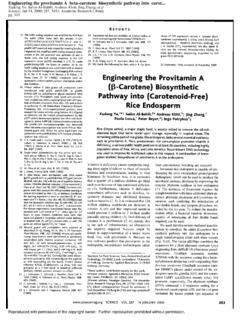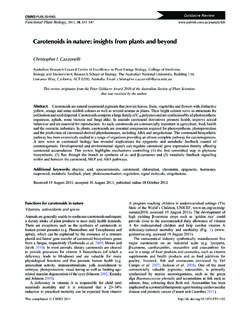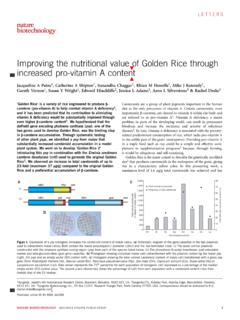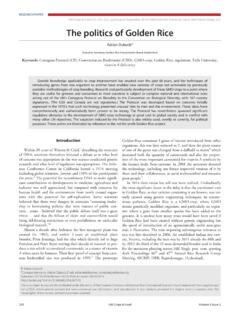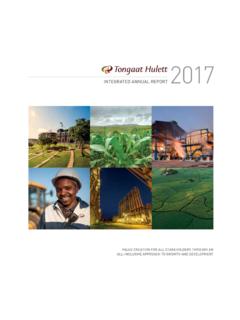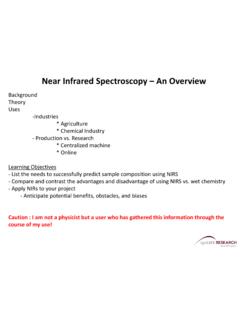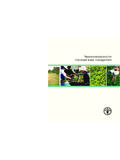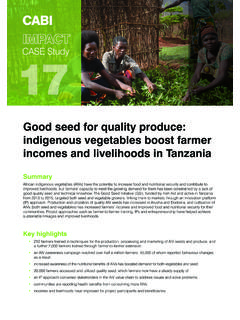Transcription of Development and Impact of Golden Rice
1 Jorge E. MayerGolden Rice Project ManagerCampus Technologies FreiburgFDA Science Forum, Washington DC, 28 April 2005 Development and Impact of Golden RiceGolden A Deficiency in the WorldVAD-related deaths in rice-based societies400 million poor in rice-based societies are Vitamin A ,000children per year go million VAD-precipitated deaths among children is the main staple crop for most of these children, but rice lacks provitaminA and other micronutrients. GMO-based Biofortification couldreduce malnutrition in a cost-effective and sustainablemanner if we adopted a rational deregulation process based on benefit / risk of energy intake for rural BangladeshStaples (rice)Non-StaplePlantsFish andAnimalSource: H. Bouis, HarvestPlusIntervention Supplementation Industrial fortification EducationLimited by Distribution, educatedmedicalstaff Centrallyprocessedfood items Onlypartiallyapplicable Economically unsustainableAlternatives required!Intervention strategies and drawbacks Centralised one-offinvestment.
2 Recurrentcosts are minimisedafter the initial research investment. Biofortifiedseeds can be distributed worldwide,although adaptive breeding is required. Biofortification complements current interventions, allof which are needed to help alleviate the of biofortificationBiofortificationAlternat iveNo germplasm available with high provitamin ASolution9 Biochemical pathway engineering using recombinantDNA technologyMilledrice controlMilledGolden RiceItscontent is sufficient to covervitamin A requirements of VAD children in rice-based contains the genes needed to produce provitamin ACarotene Desaturase (CrtI)Phytoene Synthase (PSY)Filling in the gapsProduct dev time frameBackground: Golden Rice field trialSep20041980 Technology Development -199251992-Science -1999 51999 -Product Development 200X Intellectual Property Rights20005 Material Transfer Agreements20015 HTT-competentpartner2001-20025 Transfer to indicarice varieties20025 Regulatorycleanevents20025 Regulatorycleanline at g/g20035 Regulatorycleanline at g/g20045 Experimentallinesatmuch higher levels2004 5 Agronomicnormality in field test 20045 Regulatory clean lines at 37 g/g 2005 5 Deregulation Historyof Golden Rice DevelopmentAgronomicperformance of SGR1 was not affected andpro-vitamin A content was ashigh as 6 more than 1 million children die every year from VAD, regulatory redtapehas been delaying field trials inIndia, Vietnam, thePhilippines and Bangladesh foryears, althoughno ecologist has come up with anysubstantial environmental risk stemming fromGolden Rice field trial Crowley, LouisianaJune-September 2004 SGR2 Paine et al.
3 , Nature Biotechnology 2005 23-fold increase of carotenoid content over Golden Rice ver 1 Maize PSY 80% -caroteneCarotenoid bioavailabilityFrom :112:12:1 REEstimated vit A contribution from nutrient intake for rural Bangladesh (IFPRI)50% RDA is sufficientto prevent malnutrition!Thus populations with 40% caloric intake from rice would be protected400g200gBioavailabilitystudies: USA and testing in India, the Philippines, , allergenicity, substantial equivalence, into local for deregulationin India, Bangladesh, the Philippines, Vietnam, Africa, of iron, zinc, high quality protein, vit , seed multiplication, Development and deregulation of nutritionally optimized from theSyngenta Foundation, Gates Foundation, RockefellerFoundation, HarvestPlus, USAID,Syngenta. No supportfrom the EUCommission or EUnational public granting agencies. Golden Rice going through the stancesIntrogression into locally adapted cultivarsIntrogression of the GRtrait into local Vietnamese cultivarsTransfer high -carotenefrom Taipei 309 into: High Fe/yieldvarKhangDan and highyield/good grain quality/ aromatic varietiesIR1490, CS 2000, ASS 996,Jasmine 85, OM 2031, DS 2001, MTL 250 and OM 3536 TTCHoa, Cuu Long Delta Rice ResearchInstitute, Can Tho, protein :5 Provitamin A: 5carotenoids, lutein, zeaxanthinVitamin E 5 Zincbioavailability:Ferritin, PhytaseRiceIron bio-availability:5 Ferritin, Phytase, Cystein, conventionalSorghumCassavaPotatoBananaGr andChallengesin Global HealthBiofortification and genetics-basedimprovementof the nutritional value of crops to CGIARRiceMaizeWheatCassavaBeansInternati onal, multidisciplinarySweet PotatoBackground.
4 Golden Rice field trial, Louisiana Sep 2004 Golden Ricefollow-up projectsA Public-Private Partnership at the core The Rockefeller Foundation ETH Z rich, Switzerland University of Freiburg, Germany SyngentaThe Fathers of Golden RiceGolden Deal Inventors have assigned their rights exclusively to Syngenta. Syngenta, in turn, has licensed inventors for humanitarian uses, with the right to sublicense public research institutes and low-income farmers (<US$10,000 pa) in developing countries. Farmers can replant their seed and trade them locally. Syngenta continues to support inventors and the Humanitarian Board in this task. Syngenta retains commercial rights, although it is not pursuing any commercial plans at the finally in the fieldGolden Rice Humanitarian BoardI Potrykus, Chair (ETH Zurich)P Beyer, J Mayer Univ of FreiburgA Dubock SyngentaG Toenniessen Rockefeller FoundationG Khush UC Davis (IRRI)R Bertram USAIDH Bouis HarvestPlus, CGIARW Padolina, R Wang, G Barry IRRIR Russell Tufts, USDAK Jenny SDCHumBoHumBopreparing to visit field trial preparing to visit field trial 11 Sep11 Sep20042004, , Crowley, LouisianaCrowley, LouisianaThe Golden Rice Network The Philippines International Rice Research Institute (IRRI) (Management), National Rice Research Institute (PhilRice).
5 Vietnam: Cuu Long Delta Rice Research Institute. India: Dept of Biotechnology India, Directorate of Rice Research, Indian Agricultural Research Institute, Univ of Delhi South Campus, Tamil Nadu Agricultural Univ, Agricultural Univ Patnagar, Univ of Agricultural Sciences Bangalore, Chinsurah Rice Research Station. Bangladesh: Bangladesh Rice Research Institute. Huazhong Agricultural Univ, China: Chinese Acad of Sciences, Yunnan Acad. Agricultural Sciences. Indonesia: Agency for Agricultural R&D, Jakarta. Germany: University of -based on what? With a streamlined GM regulatory framework in target countries breeding would be very advanced. Unnecessary bureaucratic hurdles willfurther delay reaching a fair number of farmersuntil 2009, ieat least 6 years of addtional waiting. Everyday 6,000children diefrom VAD,probably morethan50% in rice-based societies; thus many over-regulation saving or costinglives?And who will assume political responsibility for unnecessary suffering?
6 Background: Polished Golden paper uses a globaleconomy-wide computable general equilibrium model to analyse the potential economic effects of adopting first and second generation GMO crops in Asia. Projected gainsfrom Golden Rice adoption by developing Asia would amount to US$ bnper year globally. Enhanced productivity of Asian unskilled laborin bn US$ ;India ;othercountries in S+SEAsia Export losses due to import ban fromEurope are < !World Bank Policy Research Working Paper 3380, August 2004 Theresults suggest that farm productivity gainscould be dwarfed by the welfare gains resulting from the potential health-enhancing attributes of Golden Modified Rice Adoption : Impact for Welfare and Poverty Alleviation K Anderson, LA Jackson, CP NielsenFood-Related Illness and Death in the US2002 Meadet al., Centers for Disease Control and Prevention, AtlantaGAKnown PathogensNon-GastroenteritisKnown PathogensAcute GastroenteritisUnknown EtiologyAcute GastroenteritisGMO-derived Health ProblemsIllnessHospitalizationDeathsTota l120,00014,000,00062,000,00005,00055,000 263,00009009003,4000 Illness76,000,000 Hospitalizations323,000 Deaths5,200 GMO-derived0 Nuffield Council on Bioethics Thecurrent evidence from safety assessments of GM crops does not suggest any significant risk to people who eat them.
7 (orto the environment). Anexcessively conservative interpretation of the precautionary approach .. is fundamentally at odds .. and essentially impractical. TheEuropean Union is ignoringa moralimperative to promote genetically modified crops for their greatpotential for helping the developing world. WebelieveEU regulators have not payed enough attentionto the impactof EU regulationson agriculturein developing countries. Social needs and moral imperatives are not reflected in the present regulatory framework. Numerous scientific success stories with the potential to benefit the poor will be incapable of making it through present regulatory requirements, thereby wasting public and private dilemmaPA CHIAMSERAUPFORTUNABESAR 15 MARONGUNKNOWNPAROCBLUE ROSEBPI 76 REXOROSUPREMEKITCHILI SAMBASINAWPAGHUNKNOWNCINALATISAILTEXASRS BRGEB24 PATNABLUE BONNETPETADGWGCP231 SLO 17 BENONGIR86CP SLO 17 SIGADISIR95IR127IR8 CHOW SUNGIR262IR1103 TADUKANVELLAIKARIR400 TSAI YUAN CHUNGIR1006 MUDGOTETEPIR1163IR238TN1IR1416IR1641IR14 02IR22 TKM6IR746 AIR1704O.
8 NivaraIR1870IR1614IR2006IR579IR747IR24/ IR661IR1721IR773 ABPI 121 GAM PAIIR1915 BIR1833 GAM PAI 15IR1561IR1737IR1916IR833IR2040IR2146IR 2055IR2061IR5236IR5338 Ultimate LandracesGAM PAITSAI YUAN CHUNGIR5657 DEE GEO WOO GENBENONGCINAU nknownIR18348 LATISAILCHOW SUNGTADUKANMUDGOIR64 KITCHILI SAMBATETEPPA CHIAMSINAWPAGHSERAUPBESAR 15 UNKNOWN (JAPANESE)NAHNG MON S 4O. nivara (IRGC 101508)VELLAIKARMARONG PAROCCO 18 NAHNG MON S4 NMS 4IR 64 LandracesCrossing & selectionHundreds of accumulated genome alterations don t attract regulatory oversight Add two defined genes and regulation kicks in New varietiesBreeding tree for indica rice var IR64 MutationsRecombinationsTranslocationsDel etionsNatural geneticmodificationGolden IR64 GMO ProductDevelopment :Proof-of-concept hundreds of events regulatory cleanevent productdevelopment biosafety assessment4-8yearsof intensive experimental work withno publicationseven though data produced must be of scientific expensive process!GMO Deregulation :ExposureevaluationProteinproductionand equivalenceMolecularcharacterizationand genetic stabilityExpressionprofilingPhenotypeana lysisCompositionalanalysisEnvironmental risk assessment, etcNewcrops fromthe public sector have little chance to contribute to this optimistic scenarioin the near future, if the presentregulatory regimeis biotech crops looks impressive, increaseisbasedon onlytwotraitsand fourspecies, all developedand deregulated by theprivate sectorin and subsequently adopted by developing countries(cotton, maize, soybean, canola with herbicide-toleranceand insect-resistance).
9 Clive James ISAAA 2005 Hundredsof food-security transformation eventsproduced in the public domain in Egypt, Kenya, South Africa, Zimbabwe, China, India, Indonesia, Malaysia, Pakistan, Philippines, Thailand, Argentina, Brazil, Costa Rica, and Mexico,.. establishedin rice, maize, pearl millet, sorghum, wheat, potatoes, cassava, sweet potatoes, melons, cucumbers, squash, watermelons, tomatos, bananas, plantain, beans, papaya, sunflower, soybean, ground nut, chickpea, oil palm, cabbage, cauliflower, cacao, mango, .. with improved agronomic performance, stress tolerance, and nutritional value, *).. whichall are facingthesame regulatory, ie huge financial costingdearly*) Data , Nature Biotechnology23 (1) 20051 seed 1 plant 1,000seeds / 20 g 1,000,000seeds / 20 kg 1,000,000,000seeds/ 20 t 1,000,000,000,000seeds/ 20 KtWithin 2 years oneseed has the potentialto produce a one-year supply of foodfor100 000poor reducing VADDin a sustained andcost-effective and uncertainty have delayed the process in a morally unjustifiable Power of One (Seed) Golden Rice on the
